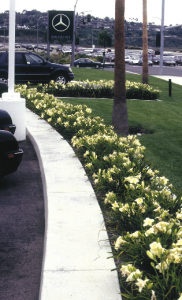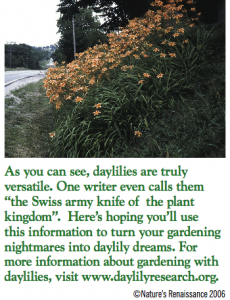Daylily Solutions
 Gardening Problems?
Gardening Problems?
We garden in order to surround our homes with beauty. Unfortunately, most of us let difficult site conditions prevent us from achieving the full potential of our gardens. Let’s look at some of the biggest gardening problems and see how a rugged, versatile perennial can help you extend the beauty of your garden.
Heavy Traffic
The parking strip between your curb and sidewalk, street medians and driveway borders are all nightmares for plants. Foot and tire trampling, road salt, dust and auto fumes are all part of the picture. Since daylilies tolerate these conditions, it is no surprise that the North Carolina Department of Transportation has used millions of daylilies to beautify roadways and interchanges. Several years ago, the North Carolina Governor (Hunt) even officially declared “The Year of the Daylily”.
By the Sea
Gardening near the ocean is a challenge. The combination of salty soils, persistent winds and airborne salt really limits your plant choices. The ancestors of modern daylilies came from coastal areas of Asia, so they can survive a surprisingly high level of salt in the air and soil and have adapted to the wind. Rather than breaking, the flexible foliage billows in the breeze. Avoid tall, heavily branched varieties that might break. Instead seek out varieties with slender, flexible bloom stalks (scapes) and smaller blooms.
Wet and Messy
All gardens seem to have areas where running or standing water causes problems. Drainage swales and basins, along with soggy areas near gutter downspouts
are hard to keep attractive. Drought tolerant and water loving, daylilies are the perfect solution. Most varieties can tolerate being submerged for up to two weeks and, as mentioned, can store water. Rather than letting water erode your garden and run off to become someone else’s problem; try creating depressions planted with daylilies where silt can settle and water can soak in.
Fire Season
In areas subject to brush fires, planting options seem to be limited and uninspired. Luckily, daylilies have recently been proven to provide great fire buffer zones. In California, fires
have burned up to the edge of daylily plantings, melting plastic sprinkler heads, but no further. Where weeds and other fuel allowed daylily foliage to burn to the ground, fresh leaves came up within a matter of weeks.
For best fire prevention, keep daylily plantings well watered. Even though grooming is not normally necessary, it is wise to remove dead bloom stalks and foliage before the fire season begins.
Steep and Slippery
Slopes are difficult for gardeners and plants. Water, instead of soaking in, runs off quickly, leading to gaps in planting and erosion. Conventional thinking calls for ground covers on slopes, when “ground holders” might be a better choice. Ground covers such as crown vetch, iceplant or gazania can cover hillsides quickly but their roots don’t do much to actually hold the soil. Patches can come loose or die out, leaving areas bare.
Daylilies are considered “ground holders” because their fleshy, water filled roots form a dense, permanent mat that will help hold the soil even if the foliage is damaged or cut back. The roots trap water as it runs down the slope, storing it for use during dry times.
 If your slope is too steep or too large to economically plant with potted daylilies, consider using bare root plants. They can be ordered by mail, allowing you to choose from the best colors and varieties for your area. Large quantities are surprisingly affordable and are installed with much less effort than container grown.
If your slope is too steep or too large to economically plant with potted daylilies, consider using bare root plants. They can be ordered by mail, allowing you to choose from the best colors and varieties for your area. Large quantities are surprisingly affordable and are installed with much less effort than container grown.
Since daylilies are slower to establish than some ground covers, you may want to sow the seed of some fast, low growing annuals to cover the surrounding soil. Sweet alyssum, California poppy and dwarf marigolds are all good choices for quick color. Planted 18 to 24 inches apart, the daylilies will eventually crowd out the annuals, along with most weeds.



